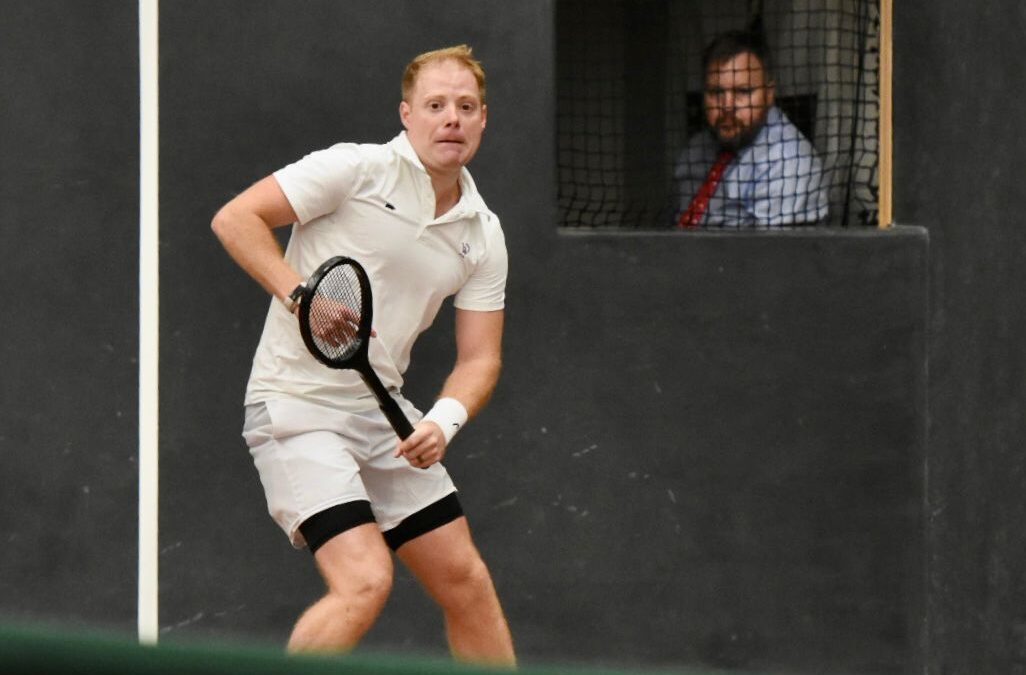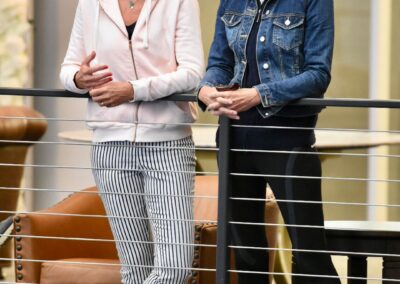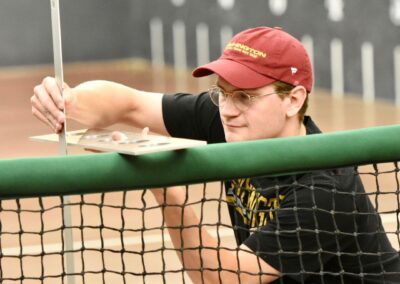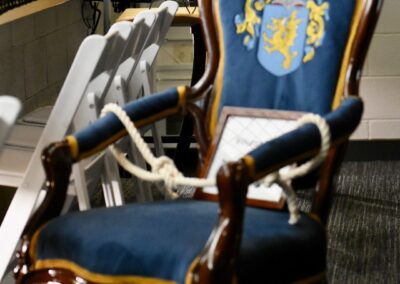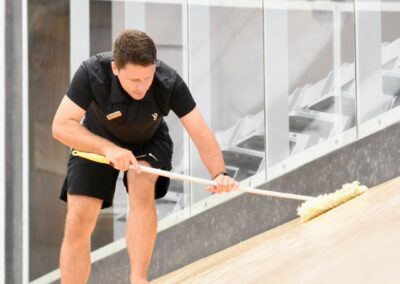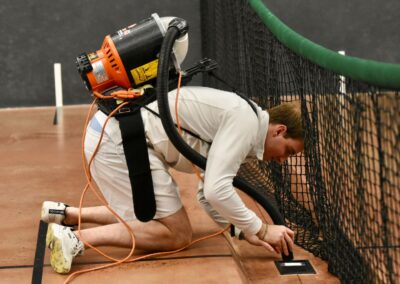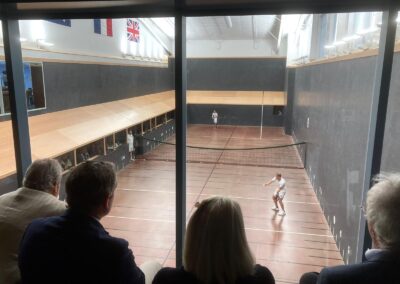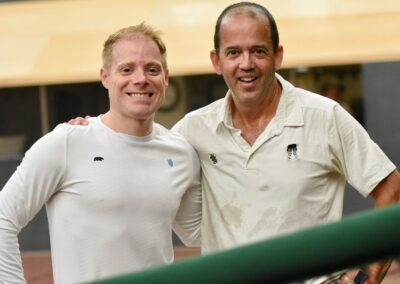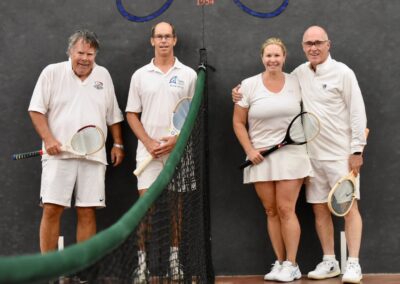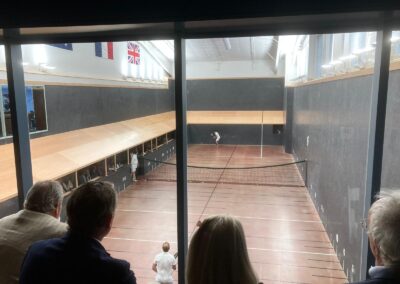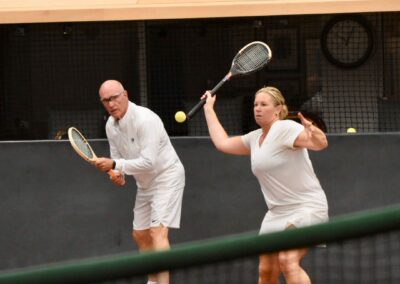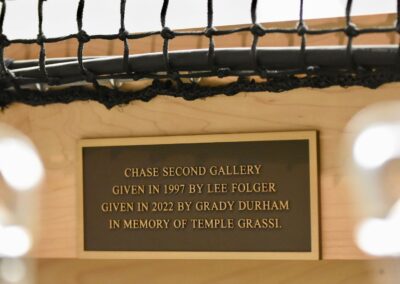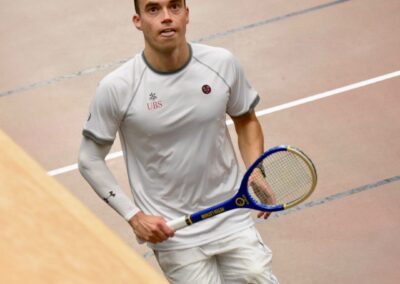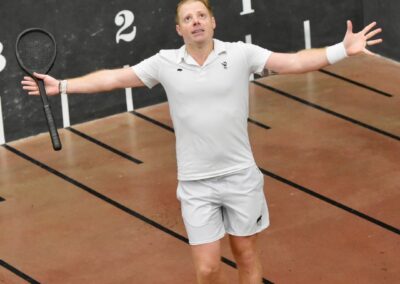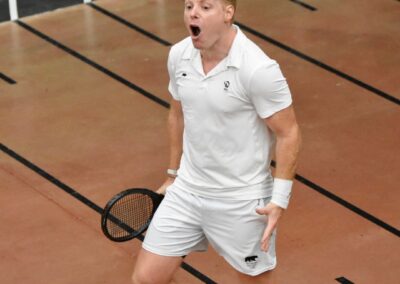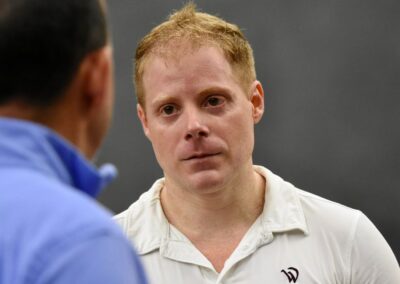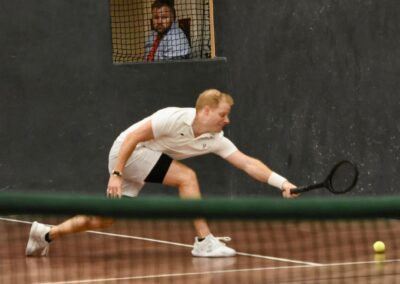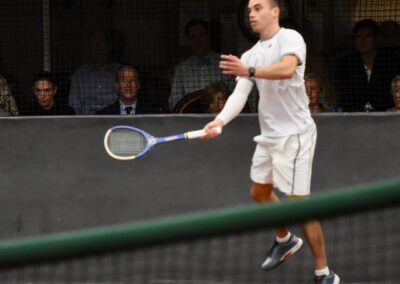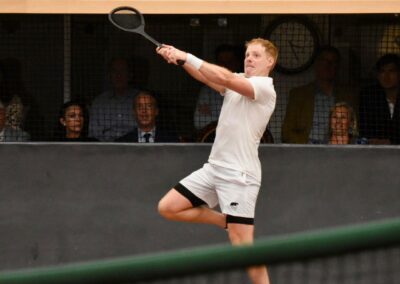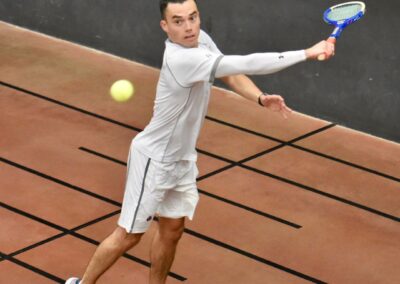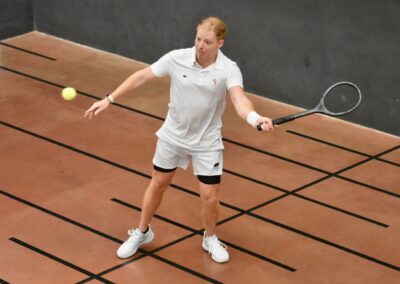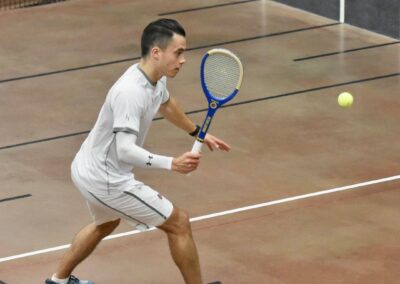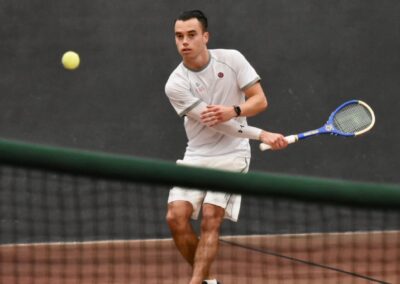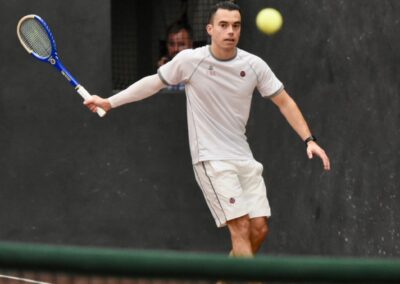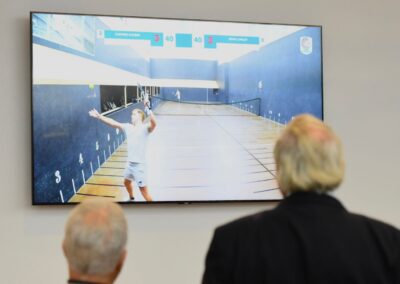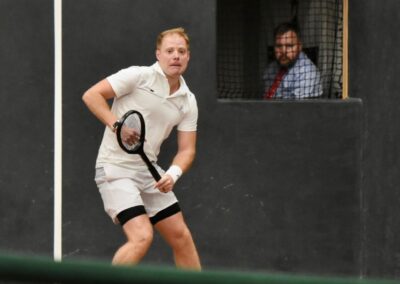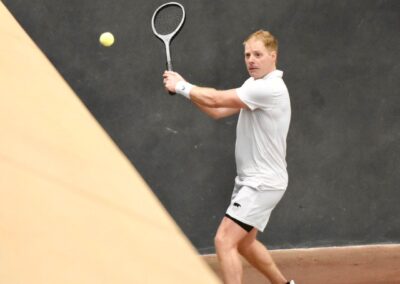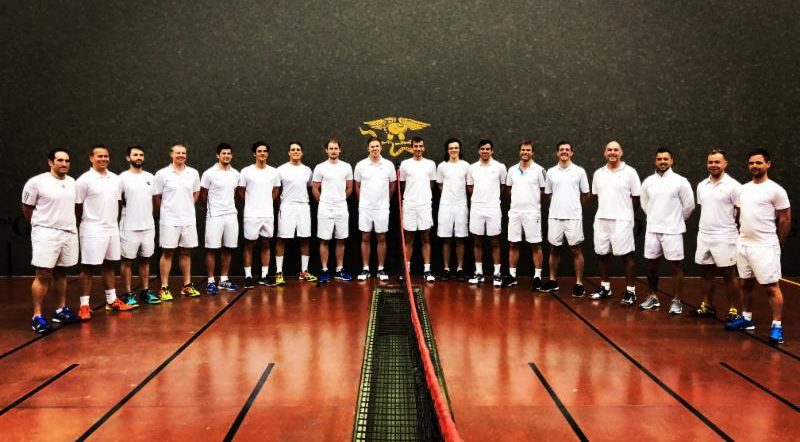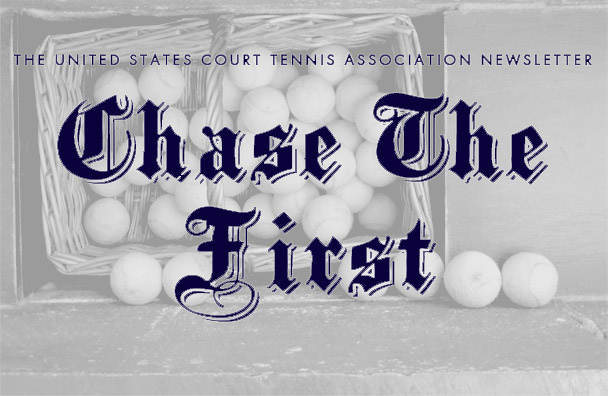by James Zug
Day One
Camden Riviere won the first four sets 6-4, 6-2, 6-3, 6-4
It was a remarkable scene at Westwood Country Club, just outside Washington City, in the suburb of Vienna. There are sixteen states in the U.S. that have a town named Vienna, but it was the Virginia one that now could boast the record for hosting the Challenge Round of the World Championship. The shortest time between a court’s original opening and hosting a Challenge: Philadelphia was just six and a half years old when it hosted in 1914 and the marble court in Dublin was just five years old when it hosted in 1895. But now Westwood, officially just ten months old since its grand opening in November 2022, was welcoming the world to the greatest tournament in the game.
It was also the end of an era. Today was the first time in forty-two years, since Chris Ronaldson and Howard Angus faced each other at Queen’s Club in 1981, that an Australian did not play in the Challenge. A stunning statistic, especially considering that before 1981 an Australian had never played in a Challenge. There were still a half dozen Aussies in the galleries, including Rob Fahey, the former world champion, and another dozen promising to descend on Westwood for the Second Day, but not having one out on court gave the atmosphere in the galleries a decidedly different and perhaps slightly more subdued flavor.
The two players: the champion, Camden Scott Riviere. The thirty-six-year-old, ginger-haired southpaw (on RealTennisOnline he was dubbed the Ginja Ninja) hadn’t lost a regular best-of-five tournament match since January 2013 when Steve Virgona (on hand at Westwood as a training partner for the challenger) topped him at the Australian Open in four sets. Since the decade since, Riviere had captured thirty-eight singles tournaments in a row, only once going even to five sets in a final. (Let’s not dilate on his doubles prowess.) The only blots in his singles copybook over that time were his losses in Challenges in 2014 and 2018. His handicap was a plus 17.5.
John Colin Lumley, the challenger. Lumley was a right-hander with a plus 10 handicap (obviously taken with a grain of salt, as it is hard to get good handicap movement at that level). He was nicknamed The Hare, both because of his rabbity movement around the tennis court and his ability to keep every strand of his jet-black hair perfectly coiffured through a match. Lumley turned thirty-one last month. He was mentored by two world champions—his mother, Penny, who captured the women’s title six times; and Chris Ronaldson, the three-time world champion, who was the head pro at Radley where Lumley apprenticed for the first three years of his professional career. That was a serious pedigree.
Nonetheless, the odds greatly favored Riviere, not only because of his win streak. Only five times since 1885, when the World Championship began in earnest with regular Challenges, has a challenger managed to beat the reigning champion in their first attempt: Tom Pettitt in 1885, Peter Latham in 1895, Jay Gould in 1914, Norty Knox in 1959 and Rob Fahey in 1994.
There was a reason for that. There was the psychological pressure of sustained play, point after point, hour after hour, the relentless pressure with nary a break. And two days later, the players had to do it again. It usually took time to learn how to adapt.
The afternoon was autumnal—in the low seventies and passing showers—began with a somber note. Alistair Curley, the master of ceremonies, greeted the overflow crowd and welcomed everyone. He then said that Temple Grassi, a driving force behind tennis in America and the creation of the Westwood court, had died exactly two years ago today. “It was his dream to have Washington host a world championship,” Curley said, “and today we remember Temple, our wonderful ambassador to the game, as we reach that goal.”
After the beautiful renditions of the British and American national anthems by baritone Ben Edquist, the marker, Ivan Ronaldson and the marker’s assistant in the grille, Matty Ronaldson, appeared. Ivan flipped a Maya Angelou quarter, Riviere won the toss and elected to serve. Riviere was in all white (shoes, wristband), except accents of black—his Wayward racquet, the Wayward logo on his shirt, his socks, his compression shorts. Lumley was more colorful, with gray sneakers with orange accents.
The first set. Lumley started off strong, laying down two chases before a point was determined and winning the first game. It was neck and neck for a while, as both players got into rhythm. Both hit primarily railroads for first serves (Westwood’s penthouse was very smooth and other serves didn’t grip and take cut) and bobbles for second serves. Riviere’s were just about ten percent better on both accounts, pinning Lumley down and forcing him to boast his return, while Riviere was able to attack and smack returns off Lumley railroads for chases or even forces. Riviere went up 5-2 but then Lumley clawed two games back, including clinching the ninth game after a spectacular rally. But Riviere clinched it. A pattern emerged, as Riviere was able to end points more often than Lumley: Riviere had four forces, two winning galleries and one grille, while Lumley totted up just one force and one grille. It was a forty-minute set.
The second set was faster and more one-sided. Riviere upped his grille total to six, including two in the first game; and one force; Lumley had one winning gallery and one grille. Riviere flew to a 4-0 lead and after a bit of a pull-back by Lumley, where he saved a couple of set points, took it 6-2.
An unexpected eight-minute break after the second set—Ivan mopped the floor and the players could change shirts—gave Lumley a chance to regroup. He won the first game of the third set and after Riviere went up 3-1 Lumely was able to peg it back to 3-3. For the third set in a row, the champion, however, won the decisive seventh game of a set. It was a long one, Riviere squandering game points and saving them as well. (Lumley had well more than a half dozen game balls throughout the match that he was unable to convert, including three in the third set when he was up 40-0 at 5-3.) Although Riviere snagged the last three games, he looked discomforted by his left forearm cramping and some evident red-faced fatigue. At the change-overs, he ate bananas and drank electrolytes but the last two sets still saw him shaking and stretching his hand in between points. Still, Riviere was able to compile an admirable amount of opening (four forces and three grilles), while Lumley had just one force and one grille.
The final set of the day was tight with tension. Lumley went up 2-0, but he was unable to stretch it out and see any real daylight between him and Riviere. The momentum shifted, perhaps when Lumley broke a string in his racquet and Riviere squeezed off four straight games. Lumley grabbed the seventh game. Riviere got it to 5-3. Lumley snatched one back; and then Riviere finished it off. Like the other three sets, a key difference was Riviere’s ability to put the ball into a point-ending gallery while Lumley struggled to do likewise: Riviere had eight forces and five grilles, including a dramatic one to take the set; Lumley had just four grilles and no forces or winning galleries. He had bad luck. At one point, playing off a chase of one and two, Riviere’s force missed under the dedans and came rocketing out to hit Lumley as he tried to dodge out of the way. Lumley saved two set points but not a third.
After two hours and fifty minutes, the first day ended with the champion up 4-0.
Photos by Tim Edwards
—

